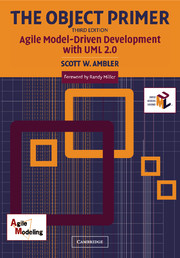Book contents
- Frontmatter
- Contents
- Acknowledgments
- Foreword
- Preface
- About the Author
- Chapter 1 Leading-Edge Software Development
- Chapter 2 Understanding the Basics–Object-Oriented Concepts
- Chapter 3 Full Lifecycle Object-Oriented Testing (FLOOT)
- Chapter 4 Agile Model–Driven Development (AMDD)
- Chapter 5 Usage Modeling
- Chapter 6 User-Interface Development
- Chapter 7 Supplementary Requirements
- Chapter 8 Conceptual Domain Modeling
- Chapter 9 Business Process Modeling
- Chapter 10 Agile Architecture
- Chapter 11 Dynamic Object Modeling
- Chapter 12 Structural Design Modeling
- Chapter 13 Object-Oriented Programming
- Chapter 14 Agile Database Development
- Chapter 15 Where to Go from Here
- Glossary
- References and Recommended Reading
- Index
Chapter 14 - Agile Database Development
Published online by Cambridge University Press: 03 March 2010
- Frontmatter
- Contents
- Acknowledgments
- Foreword
- Preface
- About the Author
- Chapter 1 Leading-Edge Software Development
- Chapter 2 Understanding the Basics–Object-Oriented Concepts
- Chapter 3 Full Lifecycle Object-Oriented Testing (FLOOT)
- Chapter 4 Agile Model–Driven Development (AMDD)
- Chapter 5 Usage Modeling
- Chapter 6 User-Interface Development
- Chapter 7 Supplementary Requirements
- Chapter 8 Conceptual Domain Modeling
- Chapter 9 Business Process Modeling
- Chapter 10 Agile Architecture
- Chapter 11 Dynamic Object Modeling
- Chapter 12 Structural Design Modeling
- Chapter 13 Object-Oriented Programming
- Chapter 14 Agile Database Development
- Chapter 15 Where to Go from Here
- Glossary
- References and Recommended Reading
- Index
Summary
Data does not have to be a four-letter word anymore.
The predominant development technologies are object technology for implementing business logic and relational database (RDB) technology for storing information. You have other options—procedural technologies such as COBOL for implementing business logic and XML-based or object-oriented databases for storage, for instance. COBOL is beyond the scope of this book and XML databases and object databases are at best niche technologies (albeit very interesting ones). My focus is on mainstream, modern development, and that means objects on the front end and RDBs on the back end.
The fit between object technology and RDB technology is not perfect. In the early 1990s, the difference between the two approaches was labeled the object/relational impedance mismatch, also referred to as the O/R impedance mismatch or simply the impedance mismatch, terms still in common use today. Why does a technological impedance mismatch exist? The object-oriented paradigm is based on proven software engineering principles. The relational paradigm, however, is based on proven mathematical principles. Because the underlying paradigms are different, the two technologies do not work together seamlessly. The impedance mismatch becomes apparent when you look at the preferred approach to access: With the object paradigm you traverse objects via their relationships, whereas with the relational paradigm you join rows of tables. This fundamental difference results in a nonideal combination of the two technologies, although when have you ever used two different things together without a few hitches?
- Type
- Chapter
- Information
- The Object PrimerAgile Model-Driven Development with UML 2.0, pp. 442 - 486Publisher: Cambridge University PressPrint publication year: 2004

